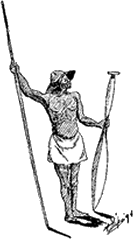 Written by Charlene Krise with Excerpts from the Twana Narratives, Native Historical Accounts of Coast Salish Culture by William W. Elmendorf
Written by Charlene Krise with Excerpts from the Twana Narratives, Native Historical Accounts of Coast Salish Culture by William W. Elmendorf
The Sa-Heh-Wa-Mish ancestors of the Squaxin Island tribe have a story of a man of importance. The story is about a warrior whose name was Qawila’s (Ka-wi-las). He was a tribal man noted for being brave and strong. Qawila’s came from the village site at the mouth of the creek in northern Case Inlet.
This area was inhabited by the band of Sqauwksin-wa-mish, also ancestors of the present-day Squaxin Island Tribe.
It is important to remember that the Salish speaking cultural activities in western Washington flowed in a vast region and covered more than just specific cultural bands of local communities. It would be difficult to define boundaries, yet the village sites give the locality of prehistoric stories.
“Long, long ago, the Kwakiutl people from way up north raided the people down here. All the tribes down here they raided and bothered. Nobody could catch them. They traveled only at night and hauled their canoes up in the woods and rested in the daytime. They took many women and slaves from all the people around here, and at last everybody got tired of those Kwakiutl coming and raiding them.”
War men of the Nisqually, Sa-Heh-Wa-Mish, Snohomish, Skagit, Suquamish, Dungeness, Lummi, Cowlitz and Skykomish met at Nisqually to decide what to do about these raiders who were taking their children, wives and slaves. These men were so angry and tired of loosing their people that they were ready to die fighting rather than have any more raids on their villages.
The warriors made battle plans. Canoes, weapons for warfare, strong young men were all called upon. Preparations for battle were being made, exhibiting battle moves and performing ceremonies of bathing and scrubbing with cedar sprigs by the warrior society. Power songs were sung to get ready for the fight. These were songs that gave strength during battle. They were songs of spirit helpers such as the eagle, the bear or the cougar.
Clamons were brought out for battle. These were very thick, thigh-length armor vests made of elkhide. The weapons consisted of arrows that had poison on the tips, bows, spears, war clubs and paddles carved to be deadly in battle.
“Kitsap was the best talker of that group. He lived by the water and he knew how to act on the water. Kitsap said, “You line up the canoes, side by side now. We are ready to go. This my power says to me, ‘You will not die! You are coming back safe!’ Qawila’s got up before the people and said, “My power says I’m not going to die! I’m coming out safe!’ And now that’s all, those two men stand up and talk, and then everybody makes ready to go.”
Two hundred canoes filled with ten to twelve men each from the Puget Sound region were sent to retaliate by raiding the Kwakiutl. The battle took place in the narrows of northern Vancouver Island.
Warriors from both war parties darkened the sky with arrows. There was the sound of splintering wood as canoes were rammed by the speed of the young warriors pulling with all their might. Seasoned warriors fought with short spears or war clubs. The sound of battle filled the marine waterways.
When a canoe was split in two, the Kwakiutl stopped shooting and tried to save themselves. The Sound warriors shot them or clubbed them in the water.
A lot of people were wounded, killed or died trying to swim. The battle continued until there were no more weapons left and some of the best warriors were lost. Both sides suffered great losses. Only a few men were left from both sides to go home to their villages and tell of the battle.
Qawila’s was one who was shot and went overboard. His canoe was smashed to pieces.
It took days before news of the battle reached the father of Qawila’s. His blind old father sat down and cried, “Oh my son! I don’t think he is dead! I taught him to get war power and I think that he didn’t die!” Every day Qawila’s father wished, “I wish I could see my son again! He’s got strong power and I don’t think he died. I hope I see my son again!“
Word came from the Klallam people that Qawila’s was alive! Qawila’s father, the old man, cried,“Oh good! Good! Good! I’ve always said, every day, that my son is still living!”
Although Qawila’s and his men from the village of Sa-Heh-Wa-Mish lost their canoe in battle, many of their men swam for survival. They found an old buoyant snag, large enough to ride the marine tide, the strong one that comes from Victoria toward Dungeness Spit.
“Dungeness people, trolling off the spit, saw something. ‘What is that on the snag?’ And the Klallam paddle out to see what that is. Now those Sa-Heh-Wa-Mish men can’t speak and they are not paddling any more. They are just going with the tide now. The Klallam put them in their canoe and ask them, ‘What are your names?’ And one of them whispered, ‘Qawila’s.’ Their legs where they have been riding that snag are all raw, all the skin is off the inside of their legs where they been riding that snag.”
A big feast was given to the surviving warriors by the Klallam people. Canoes were sent to the villages of the warriors to bring them to the honor feast. There was good food and the story of the battle was told by the warriors. Gifts were given to honor them for protecting their people.